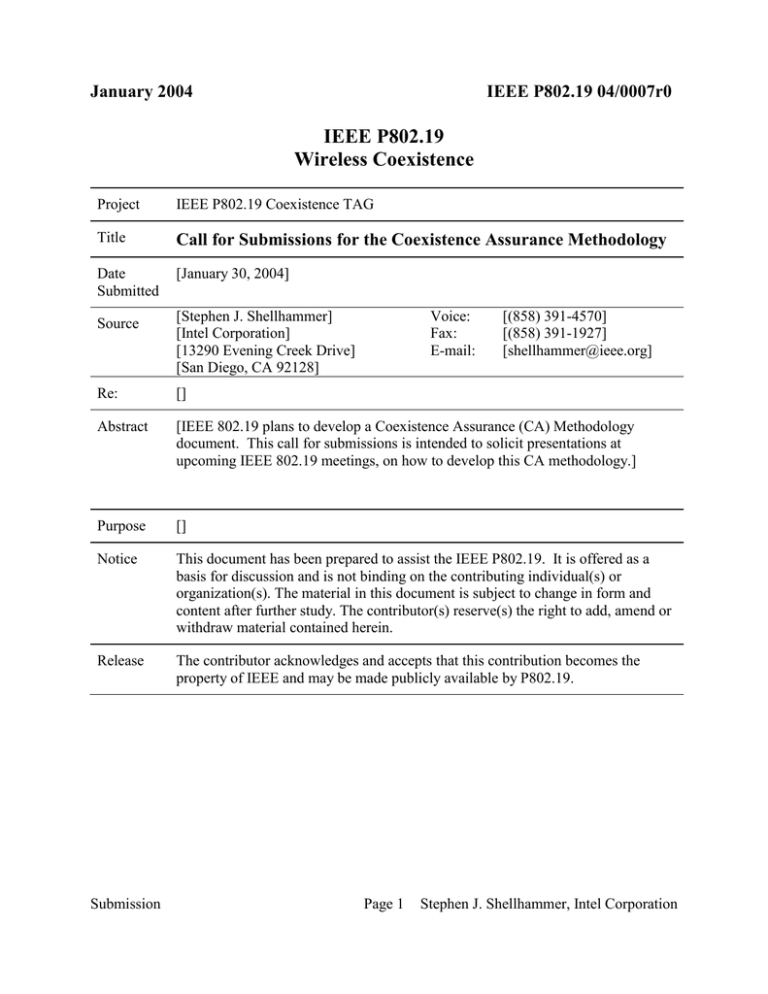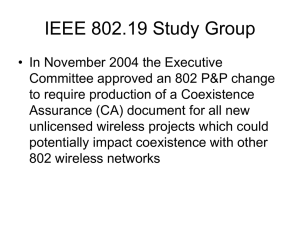IEEE P802.19 Wireless Coexistence January 2004 IEEE P802.19 04/0007r0
advertisement

January 2004 IEEE P802.19 04/0007r0 IEEE P802.19 Wireless Coexistence Project IEEE P802.19 Coexistence TAG Title Call for Submissions for the Coexistence Assurance Methodology Date Submitted [January 30, 2004] Source [Stephen J. Shellhammer] [Intel Corporation] [13290 Evening Creek Drive] [San Diego, CA 92128] Re: [] Abstract [IEEE 802.19 plans to develop a Coexistence Assurance (CA) Methodology document. This call for submissions is intended to solicit presentations at upcoming IEEE 802.19 meetings, on how to develop this CA methodology.] Purpose [] Notice This document has been prepared to assist the IEEE P802.19. It is offered as a basis for discussion and is not binding on the contributing individual(s) or organization(s). The material in this document is subject to change in form and content after further study. The contributor(s) reserve(s) the right to add, amend or withdraw material contained herein. Release The contributor acknowledges and accepts that this contribution becomes the property of IEEE and may be made publicly available by P802.19. Submission Voice: Fax: E-mail: Page 1 [(858) 391-4570] [(858) 391-1927] [shellhammer@ieee.org] Stephen J. Shellhammer, Intel Corporation January 2004 IEEE P802.19 04/0007r0 Background IEEE 802 currently does not have a standard method for predicting the impact of mutual interference between dissimilar wireless networks. As such, there is not standardized method of assuring coexistence between such wireless networks. In the process of developing new wireless IEEE 802 standards, it is important to be able to predict when the impact of interference between dissimilar wireless networks is acceptable and when it is not. The IEEE 802.19 Coexistence Assurance (CA) Methodology document will describe a method for predicting the impact of this mutual wireless interference. Interference Models In order to predict the impact of mutual interference between wireless networks it is necessary to build a model of the interference. Interference models can be built at different levels of granularity and precision. It is the intent of the IEEE 802.19 Wireless Coexistence TAG to describe in the CA Methodology several modeling techniques, at different levels of precision. The CA methodology document will explain how to develop three different interference models, each at a different level of precision. The three modeling techniques are: Interference Model – Precision Level 1 – Analytic Model This interference model is based on analytic approximations of the wireless network PHY and MAC layers. It is understood that since approximations are being uses, the accuracy of the prediction is less than the other two levels of modeling. However, the benefit of this level of precision is that the prediction of the impact of interference can be made in less time and with less effort than the other two levels of precision. Interference Model – Precision Level 2 – Hybrid Analytic/Simulation Model This interference model is uses a combination of analytic and simulation techniques. Portions of the PHY and MAC models are based on analytic approximations and portions of the models are based on simulation models. This interference model is more accurate than the analytic model but less accurate as the simulation model. The time effort required to develop such a model is more than the analytic model and less than the full simulation model. Insurance Model – Precision Level 3 – Simulation Model This interference model is bases on simulations of PHY and MAC layers of the wireless system. This model is the most accurate of the interference models; however, it requires the most time and effort to develop the model. Submission Page 2 Stephen J. Shellhammer, Intel Corporation January 2004 IEEE P802.19 04/0007r0 Call for Submissions IEEE 802.19 is interested in receiving submissions for the Coexistence Assurance Methodology document. Submissions should include a Power Point presentation and (optionally) a Word document, describing the methodology for building one of the three interference models. If you are interested in making submission on several modeling techniques, please make separate submissions for each modeling technique. Submissions should reference interference modeling techniques known in the literature. All submissions should use the standard IEEE 802.19 document formats. The document templates can be found on the IEEE 802.19 web site: http://grouper.ieee.org/groups/802/19/ All documents should have an IEEE document number and should be placed on the IEEE 802 wireless world web site: http://www.802wirelessworld.com/index.jsp The IEEE 802.19 wireless coexistence TAG will hear submission beginning at the March 2004 meeting, in Lake Buena Vista, FL. Anyone interested in presenting at the March meeting, or a subsequent meeting, please notify Steve Shellhammer (shellhammer@ieee.org) of your intension to submit, at least two weeks prior to the meeting. The document(s) should be placed on the IEEE 802 wireless world document server no later than the Friday before the meeting at which you plan to present. Submission Page 3 Stephen J. Shellhammer, Intel Corporation

